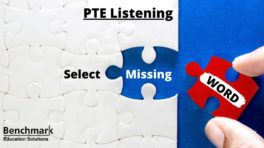Tips to Crack the PTE Listening Test – Highlight Incorrect Words


One of the most interesting and unusual parts of the PTE listening test is the section called listening highlight incorrect words. In this part of the exam, you will listen to an audio recording and then attempt to correct the transcript that is presented on the screen in front of you.
Today, I am going to present you with some of the most important information about this part of the test, including some tips to help you succeed and get a really high listening score.
What do you need to do for PTE listening highlight incorrect words?
First of all, we need to understand what you actually have to do in this part of the exam. You will be given two things: 1) a transcript of the audio recording, and 2) the actual audio recording itself. The important thing to remember is that the transcript will feature some mistakes that you need to identify. This is the fundamental purpose of the text.
How to approach this sort of PTE listening question
Prior to commencing the listening part of the test, you will have about ten seconds to prepare. During this short allotted time, you should take a look at the transcript. It is highly unlikely that you can read and comprehend the transcript in that short time, but you should attempt to skim it to determine the main idea.
Try to look for content words, which means the words that contain the most important meanings from the passage. These will usually be nouns and verbs, but of course adjectives and adverbs might also contribute some significant meaning. Whatever you can understand during this section will help you once the audio begins.
What do you do with the wrong words?
Let’s say you are listening to a passage and the speaker says:
- During the 1950s, there was a schism in the cultural landscape of the United States…
However, you notice that the transcript says:
- During the 1950s, there was a schism in the cultural composition of the United States…
What should you do in such an instance?
All you need to do is select the incorrect word, which in this case is “composition.” You do not need to change it or explain why it is wrong. You’d don’t need to know the meaning of “composition.” You simply have to click on it with the left mouse button so that it turns yellow and is identified as the problem word.
PTE listening highlight incorrect words tips
When you are doing the PTE listening highlight incorrect words task, you need to listen very carefully and be sure not to lose concentration at any point. For most of the listening tasks in this exam, you are listening for general meaning or else you will be guided to the specific point that you need to understand. However, here you literally need to pay attention to every word.
To this end, one of the most helpful things that you can do is to trace the progress of the audio recording against the transcript by using your mouse. This means that you can ensure that you hear each word and can check it against the written version. Doing this means you do not overlook a word that was changed.
For a lot of PTE listening exercises, you are strongly advised to make notes… but for this test you absolutely should NOT do that. In fact, you do not need to write anything down. This would only cause you to waste valuable time and potentially miss the correct answer.
How to practice for these questions
It is important to do daily listening practice in order to master this sort of question type, but of course you are not going to be able to replicate the exact conditions of the test in this way. One method of doing it would be asking a good friend to edit a transcript to change some wrong words, but if you don’t have a friend then you will have to be more creative.
Start by capturing short passages and then trying to transcribe them as they were written. Begin by writing down the content words and then listen again to hear the grammar words. By doing this, you can improve your ability to recognize all of the words in a piece of spoken English. Over time, of course, you will find that your skills improve and you understand more of what was said.
Finally, just watch out for those words with variable pronunciation. Sometimes these can throw people off because they seem like the wrong words but they are in fact right. That could be grammar words like “have” that sound like “of” in spoken language, or content words with unusual stress patterns.











